Abstract
An internal circulation (IC) anaerobic reactor is widely used in the treatment of municipal and industrial wastewater with high volumetric loading rates. The performance of an IC reactor is closely related with hydrodynamic behaviors of anaerobic granules. Typically, anaerobic granules work in swarms and the settling behavior of a granule is disturbed by other granules. However, the research on anaerobic granule swarms is insufficient. In this work, Computational Fluid Dynamics (CFD) method was employed to study the hydrodynamic behaviors of anaerobic granule swarms with various voidages. The simulated results showed that the average velocity inside granules increased significantly as the voidage of granule swarm decreased and as the Reynolds number increased. The maximum shear stress on the granule’s surface increased with decreasing voidage and increasing Reynolds number. Based on the hydrodynamic behaviors of anaerobic granule swarms, an improved model of drag force coefficient for granule swarms was developed. The predicted expanded height, using the improved model, gives better consistency with experimental results. The improved model can embed in CFD code to improve the precision of the description of the IC reactor model and provide valuable information for designing and operating an IC reactor.
1. Introduction
An internal circulation (IC) reactor is a widely used anaerobic reactor for municipal and industrial wastewater treatment. The hydrodynamic characteristics of anaerobic granules inside a bioreactor have a large effect on solid–liquid separation and effluent ratio of anaerobic granules. Anaerobic granules are completely different than rigid granules due to their porous and permeable characteristics [1,2]. This leads to a difference in the drag force. In addition, the performance of the bioreactor, such as the mass transfer efficiency and particle stability, is affected by the permeability and shear stress of anaerobic granules [3,4,5]. Therefore, a detailed study on hydrodynamic characteristics of granules is necessary.
Generally speaking, the number of the granules in an IC reactor is relatively high, which is useful for improving treatment efficiency of wastewater. The granules mainly exist inside the first chamber and have a larger residence time by the internal cycling flow. For higher particle density, the local flow behavior of a granule is disturbed by the adjacent granule, which is closely related with local structure and flow conditions. The movement and mass transfer of granules are accompanied by interactions between granules. It is necessary to understand the fundamentals of movement of granules in order to design and optimize this complicated flow process effectively. The calculation of the drag forces from fluid-solid and indirect solid-solid interactions is important in modeling an IC reactor for coupling fluid and solid motions. Therefore, an accurate prediction of the drag force coefficient for anaerobic granules is desired. At this point, the correlations in a swarm corresponding to those for porous granules are necessary [6]. However, none of the study research on the drag force coefficient model for an anaerobic granule swarm has been published in the literature.
As a very powerful tool, Computational Fluid Dynamics (CFD) has been applied in analyzing the hydrodynamic behaviors of particle-flow systems. Tobis [7] used the unit-cell method to investigate turbulent flow in a packed bed. The results showed that the frictional resistance coefficient is closely related with Reynolds number, bed porosity, and the bed hydraulic diameter. Magnico [8] investigated flow structures on mass transfer effect by using the unit-cell method. The mass transfer in near-wall region was found to be controlled by the diffusive mechanism at low Reynolds number. Rong et al. [9] used the Lattice Boltzmann (LB) method to investigate the effect of porosity and Reynolds number on packed bed. A new equation for mean drag force on particles was developed and better prediction results were achieved. In Liu’s work [10], the hydrodynamic behaviors of granules were studied by experimental and CFD methods. The results showed internal flow for granules is significantly dependent on permeability and Reynolds number. In their study, the permeability of aerobic granules was determined by the Happel model [11]. Kai Pan et al. [12] simulated the gas-liquid two-phase flow through the granules’ region. The results indicated that the degree of fluid turbulence had an obvious effect on the surface shear stress of granules. Our previous work [13] established the geometry structure of porous granules by the discrete element method (DEM). Based on these structures, the CFD method was used to simulate the hydrodynamic behaviors of porous granules. However, only single anaerobic granules were investigated, in which the effect of the interaction among granules was neglected. The DEM method can be used to describe the structure for anaerobic granule swarms. By this method, the local structure and flow behaviors can be studied. A detailed description and the advantages of the DEM can be found in our work [13].
The detailed hydrodynamic behaviors of granule swarms were investigated by the unit-cell method in the present study. The permeability of granules is described using porous media method. The effect of voidage and Reynolds number on the fluid hydrodynamic behaviors of anaerobic granule swarms was analyzed, including internal flow, surface shear stress, and mean drag force. An improved drag force coefficient model of granule swarms was established and evaluated.
2. Theory
2.1. Governing Equations
This study focused on the description of the flow field in and outside the granules. Therefore, the governing equations for fluid flow through the swarms can be given as:
where is the density, is the fluid velocity, is the time, is the pressure, is the viscosity of fluid. When fluid passes through the porous media region, the additional body force, such as the resistance of the porous media, can be given by the source term . For a homogeneous porous media, the fluid flow in this study can be described by Darcy–Brinkman’s law, given as:
where is the granule permeability, is the permeability factor, given as: .
Here, the Reynolds number is given as
The fluid superficial velocity can be calculated by , where is the voidage of the anaerobic granule swarm, is the mean fluid velocity, and d is the diameter of a single anaerobic granule.
The drag force of an anaerobic granule swarm is calculated as [14,15]:
In the present study, the permeability of the anaerobic granules can be calculated by the Happel model [11], which is given as:
where is the primary particle diameter, is the porosity of single granule and is a coefficient, which is related with porosity.
Mu et al. [16] investigated a serials diameter of primary particles to reconstruct the anaerobic granules and concluded that a primary particle with a diameter at 1000 μm could describe the anaerobic granules better. Therefore, 1000 μm was selected as the primary particle diameter in this research.
In our previous work [13], the mean porosity was 0.655. The permeability of the granule was calculated as 4.8097 × 10−8 m2 according to Equations (6) and (7).
2.2. Particle Distribution and Computational Domain
The geometric model can be established by the discrete element method (DEM). Particle seeds can be randomly distributed in a specified region, and the particles are generated according to the position of the particle seeds until there is no room left for the particle growth or the volume fraction of particles meets the requirements [17]. However, when the specified particle volume fraction is large, there will be insufficient space remaining in the region. At this point, gravity needs to be added to the particles in the region to make the distribution of the particles more compact so as to meet the requirement of the voidage. The diameter of sphere (d) is 2 mm in this study.
The geometry structures for granule swarms were established by DEM. The detailed fluid flow through granule swarms was investigated by the CFD method. In the simulation process, the size of the computational domain was 8d × 8d × 8d. The computational domain used in the present work was large enough according to Rong’s work [9]. The boundary of the solid phase and the fluid phase was a periodic boundary condition. In order to comply with this boundary condition, the distribution of particles on the boundary was adjusted, but the voidage was still almost the same as the voidage of the overall simulation domain. In order to eliminate possible boundary effects, the velocity of the fluid and the forces on the particles shown in this paper were limited within the length of 5d [9]. Figure 1 shows the computational domain of three representative voidages.
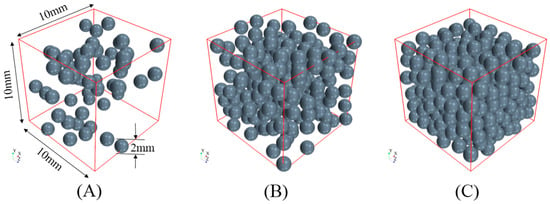
Figure 1.
Computational domains for different voidages: (A) , (B) , (C) .
The parameter settings of the meshing referred to Eppinger’s research [18]. The relative size of the surface and volume mesh can be determined on the base size. In this part, the cell numbers were obtained by adjusting the base size (0.5~10d) for the surface and volume mesh generation. The relationship between cell number and average velocity magnitude is shown in Figure 2.
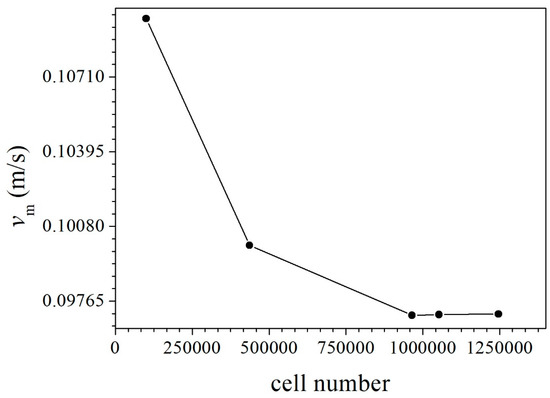
Figure 2.
The relationship between average velocity magnitudes and cell number (, ).
As shown in Figure 2, when cell numbers are >96,4763 (base size <3d), the average velocity magnitude changed slightly with the increasing cell number. Thus, the base size (1d) was used for all cases in the following section.
In our work, the CFD method was used to investigate flow behaviors through the granule swarm. The commercial software (STAR-CCM+ 12.02, Siemenz, Berlin, 2017) was applied to solve the governing equations. The method details can be found in [17]. The necessary statement can be found in the revised manuscript (Equations (1)–(3)). The laminar model was used for different Reynolds number considered in our study.
3. Results
3.1. Velocity Distribution Inside Anaerobic Granule Swarms
In this section, the main objective is to investigate the flow characteristics of fluid in the anaerobic granule swarm, in order to understand the flow state in the anaerobic bioreactor with different voidages and Reynolds numbers.
Figure 3 shows the velocity field of the fluid for the rigid and anaerobic granule swarms. The fluid flows through anaerobic granule swarms and forms a complex network. Figure 4 is a cross sectional view of Figure 3 at . It can be seen that in both the rigid sphere granule swarm and the anaerobic granule swarm, there will be a low-speed region around the granules, and a high-speed region at the center of the pores. However, for anaerobic granules, as the effect of their permeability, a part of the fluid passes through the granule interior, which makes the velocity around the granules significantly higher than that of the rigid sphere granules. Moreover, the velocity at the center of the pore is significantly lower than that of rigid spheres. This makes the external flow field of the anaerobic granules more uniform than that of the rigid sphere granules.
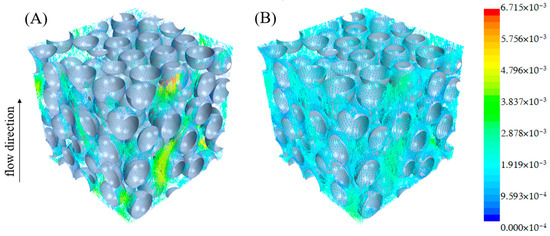
Figure 3.
Velocity vectors outside the rigid sphere (A) and anaerobic granule (B) when Re = 2.14 with the voidage of .
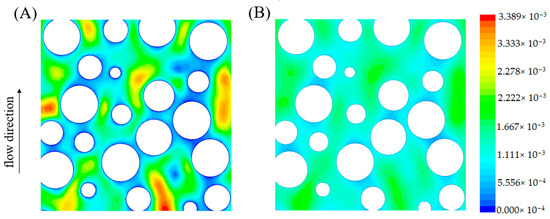
Figure 4.
Velocity contours outside the rigid spheres (A) and anaerobic granules (B) on the cross section at z = 0. (Re = 2.14, .
Figure 5 shows the velocity distribution inside and outside the anaerobic granules. The velocity distribution inside and outside the granules is found to be more uniform for larger Reynolds numbers and smaller voidage. Figure 6A shows the ratio of average velocity magnitude inside and outside the granules, which shows the same trend as Figure 5. On the other hand, Figure 6B shows that the average velocity magnitude in the granules increased significantly as the voidage decreased and the Reynolds number increased. This means that a smaller voidage and a larger superficial velocity can effectively enhance the internal convection of the granules, thereby further promoting the mass transfer inside the granules.
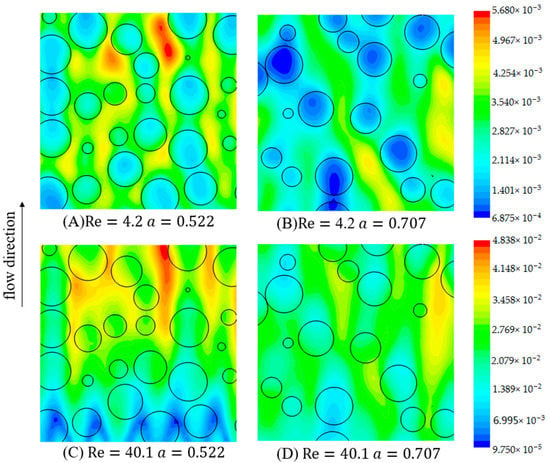
Figure 5.
Velocity contours of the anaerobic granules on the cross section at z = 0 (A) Re = 4.2 , (B) Re = 4.2 , (C) Re = 40.1 , (D) Re = 40.1 .
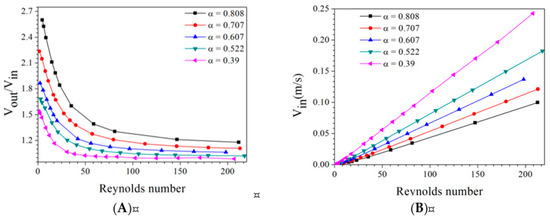
Figure 6.
The effect of Re on the (A) and the (B) of the anaerobic granule swarms with different viodages.
3.2. Shear Stress on Anaerobic Granule Swarms
In a bioreactor, shear stress has a great influence on the formation, structure, and stability of the cell-immobilization community (granular sludge) which is closely related to hydrodynamic conditions [19,20,21]. Previous studies have shown that the flow conditions and sizes of primary granules significantly affect the surface shear stress of anaerobic granules. However, the influence of the voidage on the shear stress that is exerted on anaerobic granules has not been reported.
Figure 7 shows the distribution of surface shear stress on anaerobic granules under different voidages and Reynolds numbers. With the increase of Reynolds number, the internal resistance increases, and the distribution of the shear surface shear stress becomes more inhomogeneous. The location of the maximum value of shear stress concentrates to the forward portion of the anaerobic granule swarm. With the increase of the voidage, the overall surface shear stress decreases with the same Reynolds number. Therefore, when the granule concentration is higher, the surface shear stress is larger.
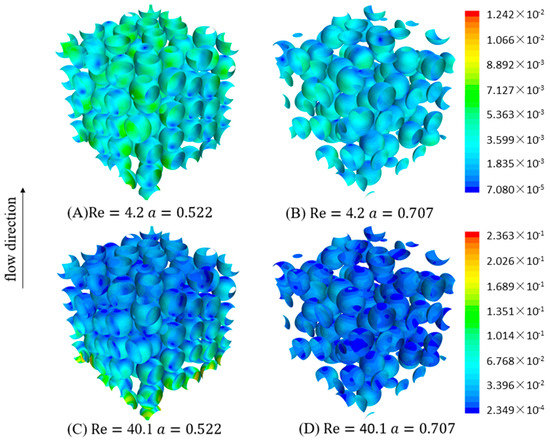
Figure 7.
The distribution of surface shear stress on anaerobic granule swarms. (A) Re = 4.2 , (B) Re = 4.2 , (C) Re = 40.1 , (D) Re = 40.1 .
Figure 8 shows the variation of maximum shear stress under different voidages and Reynolds numbers. It can be seen that with the decrease of and the increase of Re, the maximum value of shear stress increases. It can be concluded that the smaller and the higher superficial velocity the voidage of the anaerobic granule swarm make the granules easier to be broken. In general, the granules with a loose structure are broken by a larger shear force on the surface. Therefore, a smaller voidage and a higher superficial velocity would benefit the granulation of the microbial bacteria and increasing density of granules in the reactor.
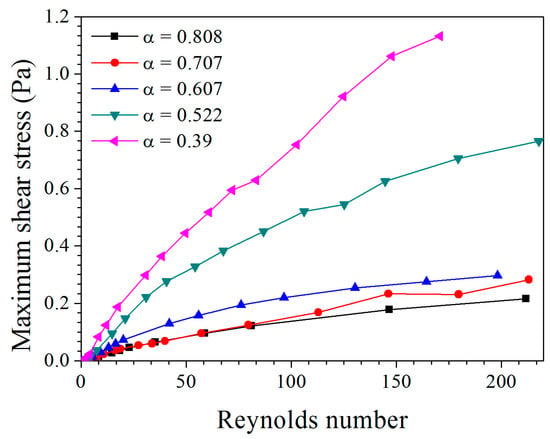
Figure 8.
The effect of Re on maximum pressure on the anaerobic granule surface.
3.3. Drag Force Coefficient of Anaerobic Granule Swarms
In order to derive an expression of the drag force between the fluid and granule swarms in a bioreactor, many variables need to be considered. If the effect of voidage is considered, Dallavalle’s model [22] is selected as follows:
where is the mean drag force, is the single-particle drag force coefficient of anaerobic granules, given as [13]:
and the correction factor is given as
There have been many studies in the past focusing on the determination of the index term of . For example, it can be considered as a constant (3.7) in Wen and Yu’s work [23], which is independent of voidage and Reynolds number. However, its applications may be inaccurate. Many efforts have been made to establish a more reliable correlation. The correlation proposed by Felice [24] is probably the most attractive one, given by
is assumed to be independent of porosity. Rong et al. [9] proposed the following equation to describe the effect of Reynolds number and voidage on the mean drag coefficient of particles by the Lattice Boltzmann method and Di Felice model, given by
In this research, the relationship among , and can be given as: . Based on Rong’s equation form and the simulated data in Figure 9, is given as:
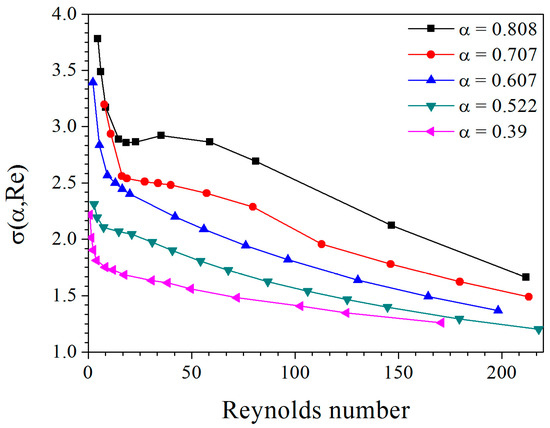
Figure 9.
Index term of corrective factor under different Re and .
In this study, two ultimate values are considered in Equation (13). In the limit of , is equal to unity. In this case, Equation (13) corresponds to the fluid flow around a single granule. On the other hand, for the limit of , , the drag force tends to be infinity, which indicates that there is no interstitial void space for a fluid to get through.
As shown in Figure 10, we compared the bed height calculated by the drag model and Wen-Yu model. It can be seen that, compared with Wen-Yu model, the bed height calculated by the drag coefficient model obtained in this study was closer to the actual situation [25]. The maximum deviation between the calculated results and the experimental results was reduced from 8.7% (Wen-Yu) to 4.8% (this study). Compared with the Wen-Yu model, the drag coefficient model in this study not only considered the influence of Reynolds number and voidage of anaerobic granule swarms, but also considered the anaerobic granules as permeable. Therefore, the model is more accurate than the Wen-Yu model in predicting the interaction between anaerobic granular sludge and sewage. Therefore, the drag force model of granule swarms can be described as Equations (8)–(10) and (13).
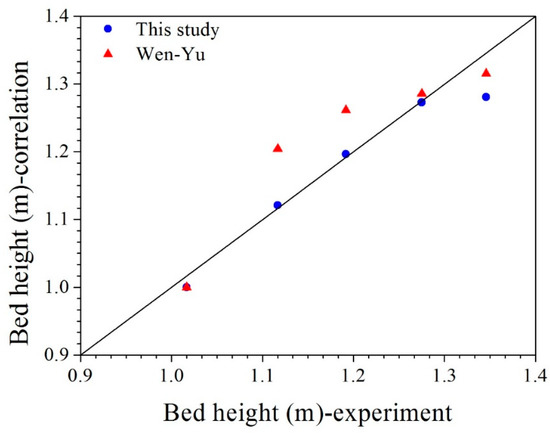
Figure 10.
Comparisons between the experimental values of bed expansion height and the calculated values by the improved model in the present study and Wen-Yu model.
4. Conclusions
The hydrodynamic characteristics of anaerobic granule swarms were studied by the unit-cell method, which is important for liquid–solid coupling and drag force analysis of granules. The simulated results showed that the average velocity inside porous granules increased significantly as the voidage of the anaerobic granule swarm (α) decreased and as the Reynolds number increased. This result indicates that with a smaller voidage and a higher superficial velocity, the internal convection of the granules enhances, thereby further increasing the mass transfer efficiency in the granules. The maximum shear stress on the granule swarms increases with decreasing voidage and increasing the Reynolds number, indicating that smaller voidage and higher superficial velocities make the granules more susceptible to breakage, thereby promoting granulation of microbial bacteria. An improved model of a drag force coefficient for granule swarms was developed. Compared with Wen-Yu model, the bed height calculated by the drag coefficient model obtained in this study was closer to the actual situation with regard to the considered flow configurations, the improved model is more suitable and can be applied for liquid-solid flow inside IC reactor.
Author Contributions
Conceptualization and methodology, X.D. and S.W.; writing—original draft preparation, S.W. and Z.G.; writing—review and editing, X.D. and Z.G.; supervision, X.D.; S.W. and Z.G. contributed equally.
Funding
This research received no external funding.
Conflicts of Interest
The authors declare no conflicts of interest.
References
- Alphenaar, P.A.; Perez, M.C.; Berkel, W.J.H.V.; Lettinga, G. Determination of the permeability and porosity of anaerobic sludge granules by size exclusion chromatography. Appl. Microbiol. Biotechnol. 1992, 36, 795–799. [Google Scholar] [CrossRef]
- Mu, Y.; Yu, H.Q.; Wang, G. Permeabilities of anaerobic CH4-producing granules. Water Res. 2006, 40, 1811–1815. [Google Scholar] [CrossRef] [PubMed]
- Chu, C.P.; Lee, D.J. Multiscale structures of biological flocs. Chem. Eng. Sci. 2004, 59, 1875–1883. [Google Scholar] [CrossRef]
- Tsou, G.W.; Wu, R.M.; Yen, P.S.; Lee, D.J.; Peng, X.F. Advective Flow and Floc Permeability. J. Colloid Interface Sci. 2002, 250, 400–408. [Google Scholar] [CrossRef] [PubMed][Green Version]
- Yang, Z.; Peng, X.F.; Lee, D.J.; Ay, S. Advective flow in spherical floc. J. Colloid Interface Sci. 2007, 308, 451–495. [Google Scholar] [CrossRef]
- Mao, Z.; Yang, C. Challenges in Study of Single Particles and Particle Swarms. Chin. J. Chem. Eng. 2009, 17, 535–545. [Google Scholar] [CrossRef]
- Tobiś, J. Influence of bed geometry on its frictional resistance under turbulent flow conditions. Chem. Eng. Sci. 2000, 55, 5359–5366. [Google Scholar] [CrossRef]
- Magnico, P. Hydrodynamic and transport properties of packed beds in small tube-to-sphere diameter ratio: Pore scale simulation using a Eulerian and a Lagrangian approach. Chem. Eng. Sci. 2003, 58, 5005–5024. [Google Scholar] [CrossRef]
- Rong, L.W.; Dong, K.J.; Yu, A.B. Lattice-Boltzmann simulation of fluid flow through packed beds of uniform spheres: Effect of porosity. Chem. Eng. Sci. 2013, 99, 44–58. [Google Scholar] [CrossRef]
- Liu, L.; Sheng, G.P.; Li, W.W.; Zeng, R.J.; Yu, H.Q. Experimental and numerical analysis of the hydrodynamic behaviors of aerobic granules. AIChE J. 2011, 57, 2909–2916. [Google Scholar] [CrossRef]
- Veerapaneni, S.; Wiesner, M.R. Hydrodynamics of Fractal Aggregates with Radially Varying Permeability. J. Colloid Interface Sci. 1996, 177, 45–57. [Google Scholar] [CrossRef] [PubMed]
- Pan, K.; Su, K.; Zhang, S.; Sun, Z.; Xu, D.; Liu, S. Hydrodynamics and permeability of aerobic granular sludge: The effect of intragranular characteristics and hydraulic conditions. Biochem. Eng. J. 2016, 113, 133–140. [Google Scholar] [CrossRef]
- Dong, X.; Wang, S.; Geng, Z.; Li, Y.; Zhang, M. Experimental and numerical analysis on the hydrodynamic behaviors of permeable microbial granules. Adv. Powder Technol. 2019, 30, 1462–1472. [Google Scholar] [CrossRef]
- Feng, Y.Q.; Yu, A.B. Assessment of Model Formulations in the Discrete Particle Simulation of Gas−Solid Flow. Ind. Eng. Chem. Res. 2004, 43, 8378–8390. [Google Scholar] [CrossRef]
- Zhou, Z.Y.; Kuang, S.B.; Chu, K.W.; Yu, A.B. Discrete particle simulation of particle-fluid flow: Model formulations and their applicability. J. Fluid Mech. 2010, 661, 482–510. [Google Scholar] [CrossRef]
- Mu, Y.; Ren, T.T.; Yu, H.Q. Drag Coefficient of Porous and Permeable Microbial Granule. Environ. Sci. Technol. 2008, 42, 1718–1723. [Google Scholar] [CrossRef]
- STAR-CCM+. Siemens. Available online: http://mdx.plm.automation.siemens.com (accessed on 5 November 2019).
- Eppinger, T.; Seidler, K.; Kraume, M. DEM-CFD simulations of fixed bed reactors with small tube to particle diameter ratios. Chem. Eng. J. 2011, 166, 324–331. [Google Scholar] [CrossRef]
- Tay, J.H.; Liu, Q.S.; Liu, Y. Aerobic granulation in sequential sludge blanket reactor. Water Sci. Technol. 2002, 46, 13. [Google Scholar] [CrossRef]
- Tay, J.H.; Liu, Q.S.; Liu, Y. The effects of shear force on the formation, structure and metabolism of aerobic granules. Appl. Microbiol. Biotechnol. 2001, 57, 227–233. [Google Scholar]
- Xue, Y.; Guo, J.; Lian, J.; Zhang, Y.; Zhang, C.; Zhao, Y. Effects of a higher hydraulic shear force on denitrification granulation in upflow anoxic sludge blanket reactors. Biochem. Eng. J. 2016, 105, 136–143. [Google Scholar] [CrossRef]
- Dallavalle, J.M. Micromeritics: The Technology of Fine Particles, 2nd ed.; PitmanPublishing Corporation: London, UK, 1948. [Google Scholar]
- Wen, C.Y.; Yu, Y.H. A generalized method for predicting the minimum fluidization velocity. AIChE J. 1966, 12, 610–612. [Google Scholar] [CrossRef]
- Felice, R.D. The voidage function for fluid-particle interaction systems. Int. J. Multiph. Flow 1994, 20, 153–159. [Google Scholar] [CrossRef]
- Chen, X.G.; Zheng, P.; Cai, J.; Qaisar, M. Bed expansion behavior and sensitivity analysis for super-high-rate anaerobic bioreactor. J. Zhejiang Univ. Sci. B 2010, 11, 79–86. [Google Scholar] [CrossRef] [PubMed]
© 2019 by the authors. Licensee MDPI, Basel, Switzerland. This article is an open access article distributed under the terms and conditions of the Creative Commons Attribution (CC BY) license (http://creativecommons.org/licenses/by/4.0/).